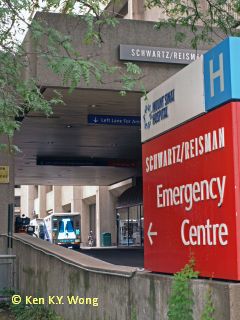
Machine learning for predicting the duration of surgery
Using preoperative factors, Deep Neural Networks can predict duration of surgery and postoperative inpatient length of stay for total knee arthroplasty with higher accuracy than simpler models. Read more…
Optimizing inter-facility patient transfer decisions during a pandemic
A proposed transfer policy leads to significant reduction of the performance metrics compared to no transfers. Most of the benefits were achieved using a maximum of 5 daily transfers per hospital. Read more…
Causes of delays in admission to rehabilitation care
A proposed model accurately captures both sources of delay, and closely matches with historical data compared to simple benchmarks. Read more…
A generic emergency department discrete-event simulation model
A single input-driven generic model is being built in Simul8. Read more…
Drone networks to deliver defibrillators for cardiac arrest
We are working with Peel Regional Paramedic Services, Duke University and others to incorporate the proposed models in real-world trials. Read more…
Tool to facilitate public health decision-making
This work focuses on supporting the refinement of a decision support tool called “CDPoRT” (Chronic Disease Population Risk Tool). Read more…
Causal structure of the Hamilton Rating Scale for depression
Causal discovery used to reveal the causal and correlational relationships among the Major Depressive Disorder symptoms. Read more…
More usable machine learning prediction for clinical decision making
Dashboard designed to present delirium identification results interactively based on physician selections and inputs. Read more…
Predicting nutrient content in donor milk using machine learning
Machine learning models were much more accurate than baseline. This allows for optimizing which donations should be placed together in donor milk pools for very-low-birth-weight infants. Read more…
Bed Capacity Planning Tool
This project provided hospitals with a set of simulation and optimization tools to help identify process improvements. A Monte Carlo simulation tool was built to estimate the patient demand for beds in a hospital during a typical week. Then, the model was applied to various real-life scenarios to identify areas of improvement. Later, optimization tools were developed to demonstrate opportunities for smoothing the expected patient demand for beds by adjusting operating room schedule. Read more…
Pandemic Outbreak Planner
morPOP is a computer-based model developed to simulate disease spread through a population, use graph theory to optimize public health policies for the purpose of mitigating outbreak impact, and answer what-if scenarios concerning pandemic spread. Examples of questions that could be answered with the model include:
- Which age groups should be prioritized for vaccination?
- Does it matter if 60% of the population is vaccinated in 12 weeks v. 15 weeks?
- What if the vaccine is 95% effective instead of 98%?
- Under what conditions should a school or subway line be closed?
- Which policy is likely better, and by how much?
- Are flu centres worth the cost and resources in this city?
Work is continuing to fine-tune policy optimization, comparison of data and strategies across cities with considerations given to their infrastructure, sensitivity analysis, and integration with Excel. Read more…
Automated Treatment Planning in Radiation Therapy using Generative Adversarial Networks
We train a generative adversarial network (GAN) to color computed tomography (CT) images. Specifically, we:
1) develop the first GAN-based prediction model for knowledge-based planning (KBP) and show that it outperforms state-of-the-art benchmarks (e.g., machine learning techniques, deep neural networks) in several clinical metrics.
2) demonstrate on a oropharyngeal cancer data set that our GAN-based KBP can successfully generate plans that often meet prescription criteria more than clinical treatment plans.
Read more…
An integer programming approach to the kidney exchange problem
Kidney paired donation is a well-established alternative to increase living donor kidney transplantation. Although the optimization of kidney exchange is a hard-to-solve problem, advanced mathematical techniques can be applied. Our approach was effective for the real-sized instances tested, outperforming another well-known integer programming formulation. Read more…
Optimization of Public Access Defibrillators Compared to Actual Deployment: An In Silico Trial
We conducted the first in silico trial of a public intervention for automated external defibrillator (AED) in Copenhagen, Denmark from October 2007 to December 2016. Mathematically optimized AED placements increased coverage of out-of-hospital cardiac arrest by approximately 50%-100% over actual AED placements in Copenhagen. Read more…
Mackenzie Health: The Internet of Things in Healthcare
The new system includes: smart beds, smart hand hygiene system, wall call stations, dome light indicators, and smart call bell system. Our results indicate its application at Mackenzie Health improved the efficiency (length of stay), patient safety (patient falls, HH- compliance rate), timeliness (patient call response time) and staff experiences. Read more…
Factors Impacting the Ordering Decisions for Red Blood Cells in a Hospital Blood Bank
Current guidelines for ordering Red Blood Cells (RBCs) are based on available inventory levels. We are investigating the implications of various factors on optimal inventory control of RBCs. Read more…
How Time to Prehospital Intervention Affects OHCA Survival for Different Subpopulations
A common interpretation of Valenzuela et al. (1997) is that out-of-hospital cardiac arrest (OHCA) survival decreases by 10% for every minute longer it takes Emergency Medical Services to administer cardiopulmonary resuscitation. We are verifying the reliability of this statistic using a much larger and more recent data set, and by examining variation among sub-populations. Read more…
Hospital-Wide Simulation of Patient Flow with both Operational and Tactical Applications
The development and application of a hospital-wide patient flow model that can be used for strategic and operational decision making. We captured hospital-specific structures and policies in an excel input file, which is then imported into a SIMUL8 model to create a unique, hospital-specific, discrete event model. Read more…
Understanding and Mitigating the Distractions/Interruptions Experienced in the OR
Naturalistic data is being collected in operating rooms at St. Michael’s hospital (Operating Room Black Box Data). Statistical analyses on the naturalistic data could help:
1) identify which distractions/interruptions may be related to surgical errors;
2) mitigate the most detrimental ones with a suitable mitigation technique.
Read more…
Dispatch Decision Making in an Air Ambulance System
Emergency medical services typically operate in highly dynamic and uncertain situations. Decision-making during dispatch must consider the different ways that patients can be transported and the estimated travel times in order to quickly and safely transfer patients. A decision support tool could therefore help standardize dispatch practice and improve time estimates. Read more…
Ambulatory Clinic Scheduling
We tested multiple scheduling scenarios using the model and considered different space allocation and hospital operating policies. This allowed WCH leadership to explore alternative policies to ultimately generate a better schedule, which has been implemented and remains currently in use. The new schedule managed to accommodate 349 clinics into a space 22% smaller than the old hospital. Additionally, 95% of the clinics remained in their historical timeslot and 88% were assigned to their preferred floor. This resulted in an increase in average utilization of examination space from 77% to 97%. Read more…
A Serious Game for Clinical Assessment of Cognitive Status
Serious games are games designed primarily for applications other than entertainment. We demonstrated the feasibility of using a serious game to evaluate cognitive status in one clinical setting, and we believe that serious games are a promising methodology for cognitive screening in different clinical settings, including the high-acuity time-pressured Emergency Department environment. Read more…
Temporal Barriers to Accessing Defibrillators Placed in Public Locations
Automated external defibrillators (AEDs) must be both geographically and temporally accessible to assure maximal availability for treatment and response to out-of-hospital cardiac arrest (OHCA). We calculated the OHCA coverage of the registered AEDs in Toronto to find the effects of limited temporal accessibility. We also developed a novel spatiotemporal AED placement optimization model using both temporal and spatial information of OHCA cases and candidate locations for placing AEDs. Read more…
Perioperative Decision Support Tool
This research proposed a generic simulation model of perioperative patient flow to inform tactical decision making for improved performance. The model was successfully applied to six hospitals, demonstrating its value as a decision-making tool. The result was a generic model that was created based on typical perioperative flow processes and best practices. Read more…
Optimal Admission and Discharge Decision-Making in an Intensive Care Unit
An Intensive Care Unit (ICU) houses some of the most critically ill patients in the healthcare system. To develop a model to help maximize patient flow within an ICU, we collected data during its daily operations and recorded preferences in the decision-making of physicians and nurses. This data-driven approach helps capacity planning by showing the impact of their admission and discharge decisions as well as that from downstream bed capacity. Read more…
Optimisation Planning for Photodynamic Therapy
New light delivery technologies providing greater penetration depths have prompted a rebirth in the field of interstitial photodynamic therapy. In this study, prostrate treatment was used as the test case for optimising therapy planning. The main impact of increasing the number of diffusers up to optimal is to improve prostate coverage without over-dosing more rectum. Read more…
Systematic Interruption Management in Intensive Care
A participatory approach was used to design a task-severity awareness tool (TAT), which consisted of an LED display hung above the door of an Intensive Care Unit room that could be activated by nurses using buttons or foot pedal inside the room. TAT showed promise in mitigating non-urgent interruptions. Read more…
Optimal Scheduling Policy for Elective and Emergency Surgeries

The challenge is to schedule elective and emergency surgeries so that the utilization of operating rooms is maximal while minimizing the delay or cancellation of pre-scheduled elective surgeries. The research involves two scheduling approaches: traditional static scheduling and dynamic scheduling under uncertainty. Preliminary numerical studies indicate that an effective scheduling policy may reduce overnight stay among surgical patients by 26%. Read more…
